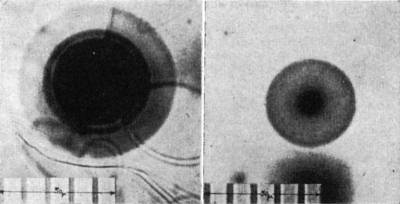|
Earth Science Associates |
|||||||||
|
||||||||||
|
Creation's Tiny Mystery |
||||||||||
|
|
< Prev T of C ... 12 13 14 15 Epi. Cat. App. Ref. Cred. Next > Fossil Alpha-Recoil Analysis of Certain Variant Radioactive HalosScience, vol. 160, pp. 1228-1230, 1968.Abstract. The distribution of alpha-radioactivity in the vicinity of uranium and of certain variant radioactive halos in biotite was investigated by the fossil alpha-recoil method. Within the limits of the method I could not confirm a previously proposed hydrothermal mechanism for the origin of certain variant halo types due to polonium isotopes. Microscopic examination of thin sections (≈ 20 μ) of certain minerals sometimes reveals a distinctive pattern of colored concentric rings surrounding a minute central inclusion about 0.5 to 1 μ in radius. Although these structures had long been observed by mineralogists, their origin was a mystery until almost simultaneously Joly (1) and Mugge (2) correctly attributed the phenomenon to the presence of radioactivity in the central inclusion. While in some instances the inclusions have been identified as zircon (1, 3), xenotime, or monazite (4), the halo nuclei are often too small for petrologic analysis. In polarized light, the appearance of the varicolored ring patterns in such anisotropic minerals as biotite suggested the designation "pleochroic halos," although "radioactive halos" is clearly more appropriate. While the radioactivity in the central inclusion may consist of α-, β-, and γ-radiation, the development of a halo is basically due only to the proportionately much higher ionization effects of the α-particles. This is an extremely fortuitous situation because, since the α-particle has a rather precise range R in a mineral for a given initial energy E, one can often ascertain not only the elements responsible for a particular halo type but also the specific isotopes. If the halo nucleus contains uranium, the α-emission from the eight α-emitters in the decay chain produces a region of radiation damage surrounding the inclusion. In certain biotites this region becomes faintly visible when about 108 atoms of 238U have decayed; with increased α-emission a series of colored, spherically concentric shells eventually appears, corresponding to the ranges of the respective α-emitters of the 238U decay chain. The three-dimensional nature of the halo becomes strikingly apparent when a sample of biotite is prepared for microscopy. The leaves of a book of mica are easily cleaved with transparent cellophane tape, and each successive layer of mica reveals a ring pattern of increasing size until the diametral section is obtained. Years ago there was great interest in the ring structure of uranium and thorium halos in investigation of the invariance of the radioactive transformation rate over geological time (5). It is in this connection that radioactive halos have again drawn interest (6). Naturally ring sizes are always measured from diametral sections; results are best from specimens having exceptionally small nuclei. Use of a filar micrometer shows the ring radii for the uranium and thorium halos to agree very well with the calculated α-particle ranges of 238U and 232Th and their respective α-emitters. Thus an experimental range:energy relation for α-particles may be determined for any mineral containing well-defined uranium or thorium halos, with small central inclusions. Certain types of halos (I call them variant halos) exist that cannot be identified with the ring structure of either the uranium or thorium halos. What is the nature of the α-emitters responsible for these variant halos? Several types of variant halos were discovered but were not claimed to be evidence of new α-emitters because radioactive-decay schemes of uranium and thorium were still being refined. Nevertheless Joly (7) reported three variant halo types: one he attributed to "emanation" (222Rn), a dwarf having a very small radius; another was simply designated the X-halo. Others (8-10) have reported unusual halo sizes, and I have found halos having anomalous ring structure (11, 12). For greater clarification of the variant halos, I classify as class I those rather easily identifiable with known α-emitters; as class II, those (such as Joly's X-halo) whose ring structure has not been correlated with known α-emitters. For example, Henderson reported four variant halo types: A, B, C, and D. Types A, B, and C were correctly attributed to the polonium isotopes 210Po, 214Po, and 218Po, respectively; thus they are of class I. But I have been unable to confirm Henderson's association of the D-halo with 226Ra (13). I confine this report to investigation of class-I halos—in particular to analysis of Henderson's proposed origin of the polonium halos. The polonium isotopes have relatively short half-lives; any mechanism proposed for their origin must be consistent with this fact. The 218Po halo (Fig. 1, left), so-called because 218Po is the initiating isotope, exhibits three rings arising from successive α-decay of 218Po (E1, 6.0 Mev; r1, 23 μ), 214Po (E2, 7.68 Mev; r2, 34 μ), and 210Po (E3, 5.3 Mev; r3, 19 μ). Ei and ri denote, respectively, the α-particle kinetic energy and the corresponding average halo-ring radius. By analogy the 214Po and 210Po halos (Fig. 1, right) are, respectively, dual and single ring patterns. I have observed the polonium halos in many Precambrian biotites, and the halos in Fig. 1 were found in biotites from the Baltic (Norway) and Canadian shields, respectively. Since these polonium isotopes are daughter products of 238U, it was initially conceived (10) that they were preferentially fixed out of uranium-bearing solutions at localized deposition centers along small conduits or veins within the host mineral (mica, for example).
Doc.: T of C #1 #2 #3 #4 #5 #6 #7 #8 #9 ... < Prev T of C ... 12 13 14 15 Epi. Cat. App. Ref. Cred. Next > |
|
|||||||
|
|
||||||||||
|
||||||||||
|
Earth Science Associates
|
||||||||||



